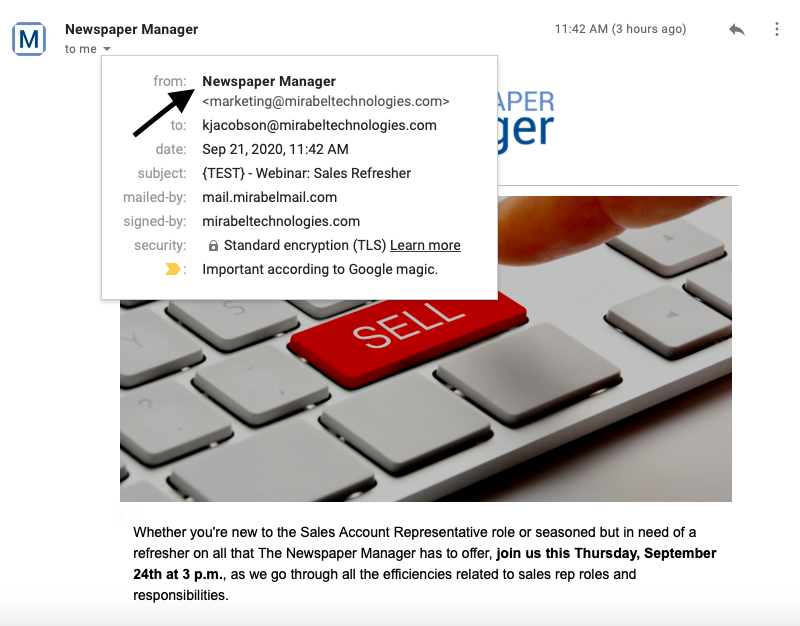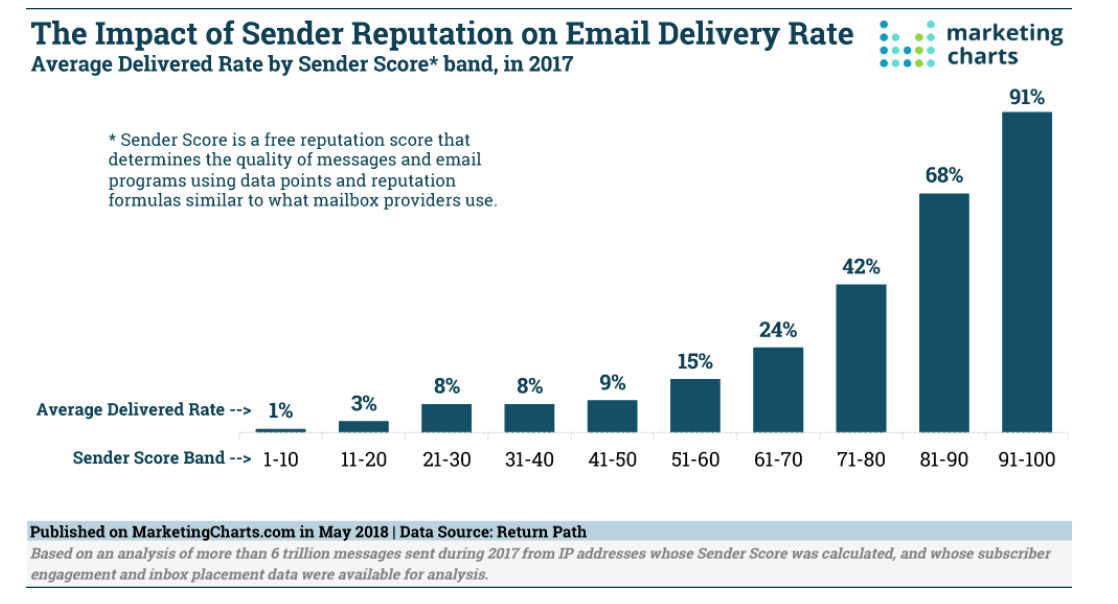Most marketers are aware of brand reputations, managing the on- and offline perceptions of their company. Yet, are you aware of your sender email reputation?
If you’re hitting the inbox of opt-in recipients every time, your sender reputation is top notch. Well done! However, if your email marketing campaigns are ending up in the spam folder, your sender email reputation is poor. So, why is your sender reputation poor?
- Your email list contains recipients who didn’t opt-in to your email marketing campaigns, and they’re marking your emails as spam. This is especially common if you purchase or borrow email lists, which is not a recommended practice.
- Your email engagement rate is lower than average. An engagement rate is determined when a recipient opens, clicks through, replies, or forwards your email. A low engagement rate is especially common if too many of your recipients delete your email without opening it. This repetitive action automatically indicates to inbox providers that all emails from this address are spam.
- The hard bounce rate is higher than average. A hard bounce is a permanent email deliverability problem (unlike a soft bounce) and indicates that an email cannot be delivered for one of two reasons:
- It’s being sent to an invalid email address that’s misspelled, incorrectly formatted, or non-existent. Some email marketing software mark catch-all email addresses, such as test@company.com, as invalid. These catch-all addresses are typically used by inbox providers to find senders who are purchasing or borrowing email lists. Common catch-all email addresses can also include marketing@company.com, accounting@company.com, and so on.
-
- The inbox provider has blocked the delivery of all your emails. This could be because the recipient marked you as spam or abuse too many times, and your sender reputation has been blacklisted.
It’s easy to avoid these common email deliverability problems, but coming back from a poor sender reputation is tricky. It’s a longer-term process that requires an organic increase in email deliverability. Take a few email marketing strategies from Mirabel’s Marketing Manager on how to improve your email deliverability and sender reputation:
Understanding Email Deliverability
Email deliverability is defined as landing your email communications in your recipient’s inbox. To understand how to improve your email deliverability, you must comprehend a few basic email terms that we’ll talk about:
- Sender reputation is also known as email sender reputation, sender score, or email reputation. According to SparkPost, a sender reputation is “a score that an Internet Service Provider (ISP) assigns to an organization that sends email. It’s a crucial component of your email deliverability. The higher the score, the more likely an ISP will deliver emails to the inboxes of recipients [in their email lists].” The lower the score, the more likely an ISP may automatically send your email to the spam folder or block you. Each ISP has a criteria for determining a sender score, so your sender score is likely different for each ISP. This means your email communications may deliver to some inboxes but not others. This criteria can include but is not limited to:
- The amount of emails sent by the organization
- Number of spam or send abuse complaints
- How often the organization’s emails hit the ISP’s spam trap
- If the organization is on any blacklists
- The number of soft and hard bounces
- The engagement rate
- The unsubscribe rate
- An Internet Service Provider (ISP) is a company that provides users with access to the Internet. In email marketing, ISP refers to major email providers: AOL, Outlook, Yahoo Mail, Gmail, Comcast, and so on. The term is commonly interchangeable with Inbox Service Providers or inbox providers when referring to email marketing.
- IP stands for Internet Protocol. An Internet Protocol address is a numerical label assigned to each digital device connected to a computer network that uses the Internet Protocol for communication. An IP address is used for either hosting a domain or network interface identification and location addressing. For email marketing, an IP address serves both functions.
- A domain in email marketing is the portion of the web address that follows the @ symbol. “For example, in JohnDoe@company.com, ‘company.com’ is the email domain. An email domain … must match the requirements of the hosting provider, consisting of only letters, digits, hyphens and dots,” according to iContact. Like sender reputations, domains also have reputations; however, the two are not interchangeable terms.
- A subdomain separates individual sender reputations from the main sender reputation by creating separate sender addresses. For example, in test@example.com, the main domain is example.com. This means example.com has the largest sender reputation. For an email with a subdomain, it would look like test@shopping.example.com. The subdomain, shopping.example.com, has a separate smaller sender reputation from example.com. Check out the anatomy of an email address below.
Prepping Your IP for a Positive Domain Reputation
It’s important to understand that the reputation of your IP address is often the responsibility of your Internet Service Provider’s server. However, the domain and sender reputations are solely your responsibility to manage. This means even if your ISP’s server is working, your emails can still be blocked by the ISP because your domain and/or sender reputations are poor.
One of the best strategies to increase email deliverability is to prep your IP address for a successful domain reputation. With a positive domain reputation, a positive sender reputation will likely follow.
Step 1: Send to Your Email List Gradually
Every email IP address begins with virtually no credibility, so you must prepare it to receive and send email communications properly. First, you must create and send relevant emails to a small reliable email list in order to build IP address credibility. This small email list will likely engage with your email and increase open and click-through rates. Remember: A high engagement rate increases your email reputation.
After building a positive sender reputation with a small email list, gradually build your email list. As you begin to grow your email marketing campaigns, email deliverability steadies, because inbox providers recognize your sender address (or “from address”) as credible.

The from address or sender address, as seen in a newsletter email for Gmail, for The Newspaper Manager is marketing@mirabeltechnologies.com.
Step 2: Set Up a Sender Policy Framework
Additionally, you must take preventative measures to ensure your IP address is correctly protected from the get-go. Set up an SPF (sender policy framework) record, which authenticates the sender address of an email. An SPF record verifies “that a mail server is authorized to send email for a specific domain. An SPF record [contains] a list of the IP addresses that are allowed to send email on behalf of your domain.”
Without a secure SPF record set up, spammers can use your domain to send spam, a technique called spoofing. This will give you negative domain and sender reputations, decreasing email deliverability.
Step 3: Make a Subdomain
Another way to protect your sender reputation is to set up a subdomain. This is helpful for companies with multiple departments that have different types of email campaigns being sent out. An email containing order information or a product update shouldn’t come from a domain that’s used for marketing communications. The email lists would be different, and recipients would likely flag irrelevant emails as spam.

This example from Hive.co demonstrates the anatomy of an email address, including the domain and subdomain.
Strategizing for a Positive Sender Reputation
A positive sender reputation is a near-guarantee to improve email deliverability in marketing. A steady positive sender score emphasizes stability and consistency, two necessary qualities to have when ISPs determine which emails can land in their users’ inboxes.
Return Path (now Everest), an email optimization and deliverability product by Validity, analyzed more than 6 trillion email messages sent in 2017 from IP addresses whose sender reputations were calculated and whose engagement and inbox placement data was available. The 2018 report determined that the higher sender scores led to better email deliverability rates:
- 91% for senders with a score of 91-100
- 68% for senders with a score of 81-90
- 42% for senders with a score of 71-80
- 24% for senders with a score of 61-70
- 15% for senders with a score of 51-60

So, how can you increase your sender score? How do you know where your email deliverability stands among popular inbox providers?
- Clean your email lists. Also known as scrubbing, cleaning your email lists allows you to keep sending messages to only engaged subscribers. It avoids opt-out and/or unsubscribed contacts who won’t engage, which can hinder your sender score.
- Verify your email addresses. Upon getting new contacts or while scrubbing older lists, it’s important to sift through addresses to differentiate valid and invalid emails. Few digital marketing software, including Mirabel’s Clean Your Lists, offer email verification tools that flag invalid or unknown email addresses to avoid spam traps, phishing or honeypot scams, and unengaged emails.
- Find duplicate email addresses. Oftentimes, repeat but inconsistent website visitors forget they’ve already input their email address. They’ll keep submitting it to your email list, and some fledging email marketing tools will allow you to send a single email multiple times to one address. If a recipient receives the same email multiple times, they’re likely to report as spam. More robust email marketing tools, like Mirabel’s Marketing Manager, will auto-flag duplicate addresses, keeping your sender score high.
- Double down on opting in. All email lists should contain only addresses that have opted in to receive your email communications. The double opt-in method lowers hard bounce rates, which increases your sender score. The double opt-in method is when a website visitor fills out a form that explicitly states, usually in a non-negotiable checkbox, their email address will be used to receive marketing and sales communications. Before the visitor can begin receiving these emails, they must log their email address twice on this form for confirmation. Many organizations also use a confirmation workflow, so a user must confirm their email address via automated message before proceeding with creating or updating an account. Using this confirmation tactic ensures that the visitor is aware of what they’re opting into and that the email is valid and engaged.
- Send relevant content. As mentioned before regarding subdomains, users who opt-in to receive only product updates don’t want sales pitches. If a recipient receives irrelevant content, they’ll likely flag your email as spam or unsubscribe. A key strategy to increase email deliverability is to increase engagement by sending relevant content.
- Capture their attention. Emails are a primary form of personal and professional communication, so inboxes can get cluttered very quickly. Ensure your email stands out to its intended recipient by creating a catchy subject line and subheader. The key is to avoid a mass or automated email tone, and personalize the message.
Whether you need to increase your sender score after a blacklist hit or you’re beginning email marketing for the first time, these tried-and-true tips for a great sender reputation will help increase email deliverability and land in your email lists’ inbox.
To learn more about the basics of email marketing and sender reputations, download A Beginner’s Guide to Email Marketing by Mirabel’s Marketing Manager. Click on the button below to download your copy:
Isabella McKinnon contributed to this blog.
SEE FOR YOURSELF
Watch an overview to learn how B2B marketing automation by Mirabel Technologies can help you increase traffic, optimize your funnel, drive more leads, improve conversions, and boost ROI — at a price you can afford!

